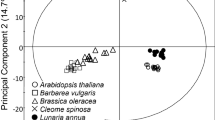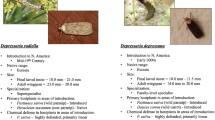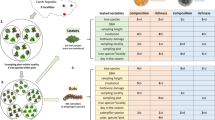Abstract
Insect herbivores have evolved a broad spectrum of adaptations in response to the diversity of chemical defences employed by plants. Here we focus on two species of New Guinean Asota and determine how these specialist moths deal with the leaf alkaloids of their fig (Ficus) hosts. As each focal Asota species is restricted to one of three chemically distinct species of Ficus, we also test whether these specialized interactions lead to similar alkaloid profiles in both Asota species. We reared Asota caterpillars on their respective Ficus hosts in natural conditions and analyzed the alkaloid profiles of leaf, frass, caterpillar, and adult moth samples using UHPLC–MS/MS analyses. We identified 43 alkaloids in our samples. Leaf alkaloids showed various fates. Some were excreted in frass or found in caterpillars and adult moths. We also found two apparently novel indole alkaloids—likely synthesized de novo by the moths or their microbiota—in both caterpillar and adult tissue but not in leaves or frass. Overall, alkaloids unique or largely restricted to insect tissue were shared across moth species despite feeding on different hosts. This indicates that a limited number of plant compounds have a direct ecological function that is conserved among the studied species. Our results provide evidence for the importance of phytochemistry and metabolic strategies in the formation of plant–insect interactions and food webs in general. Furthermore, we provide a new potential example of insects acquiring chemicals for their benefit in an ecologically relevant insect genus.


Similar content being viewed by others
Data availability
Data will be made available from the Dryad Digital Repository on publication of the manuscript.
References
Allio R, Nabholz B, Wanke S et al (2021) Genome-wide macroevolutionary signatures of key innovations in butterflies colonizing new host plants. Nat Commun 12:354. https://doi.org/10.1038/s41467-020-20507-3
Anderson TJ, Wagner DL, Cooper BR et al (2017) HPLC-MS analysis of lichen-derived metabolites in the life stages of Crambidia cephalica (Grote & Robinson). J Chem Ecol 43:66–74. https://doi.org/10.1007/s10886-016-0799-3
Basset Y, Novotny V, Weiblen G (1997) Ficus: a resource for arthropods in the tropics, with particular reference to New Guinea. In: Watt AD, Stork NE, Hunter MD (eds) Forests and insects. Chapman & Hall, London, pp 341–361
Bates D, Mächler M, Bolker B, Walker S (2015) Fitting linear mixed-effects models using lme4. J Stat Soft 67:1–48. https://doi.org/10.18637/jss.v067.i01
Becerra JX (1997) Insects on plants: macroevolutionary chemical trends in host use. Science 276:253–256. https://doi.org/10.1126/science.276.5310.253
Beemelmanns C, Guo H, Rischer M, Poulsen M (2016) Natural products from microbes associated with insects. Beilstein J Org Chem 12:314–327. https://doi.org/10.3762/bjoc.12.34
Braga MP, Janz N, Nylin S et al (2021) Phylogenetic reconstruction of ancestral ecological networks through time for pierid butterflies and their host plants. Ecol Lett 24:2134–2145. https://doi.org/10.1111/ele.13842
Brooks ME, Kristensen K, van Benthem KJ et al (2017) glmmTMB balances speed and flexibility among packages for zero-inflated generalized linear mixed modeling. The R Journal 9:400. https://doi.org/10.3929/ethz-b-000240890
Cogni R, Trigo JR, Futuyma DJ (2012) A free lunch? No cost for acquiring defensive plant pyrrolizidine alkaloids in a specialist arctiid moth (Utetheisa ornatrix). Mol Ecol 21:6152–6162. https://doi.org/10.1111/mec.12086
Costa ÂCF, Cavalcanti SCH, Santana AS et al (2019) Formicidal activity of indole derivatives on Atta opaciceps (Borgmeier): lethal, behavioural and locomotive effects. J Appl Entomol 143:58–68. https://doi.org/10.1111/jen.12569
Dussourd DE (2017) Behavioral sabotage of plant defenses by insect folivores. Annu Rev Entomol 62:15–34. https://doi.org/10.1146/annurev-ento-031616-035030
Dyar HG (1890) The number of molts of lepidopterous larvae. Psyche 5:420–422. https://doi.org/10.1155/1890/23871
Endara M-J, Coley PD, Ghabash G et al (2017) Coevolutionary arms race versus host defense chase in a tropical herbivore–plant system. Proc Natl Acad Sci USA 114:E7499–E7505. https://doi.org/10.1073/pnas.1707727114
Fordyce JA, Nice CC (2008) Antagonistic, stage-specific selection on defensive chemical sequestration in a toxic butterfly. Evolution 62:1610–1617. https://doi.org/10.1111/j.1558-5646.2008.00388.x
Guo H, Yang M, Qi Q (2014) Insecticidal and antifeedant effects of two alkaloids from Cynanchum komarovii against larvae of Plutella xylostella L. J Appl Entomol 138:133–140. https://doi.org/10.1111/jen.12075
Hartig F (2022). DHARMa: Residual Diagnostics for Hierarchical (Multi-Level / Mixed) Regression Models. R package version 0.4.5. https://CRAN.R-project.org/package=DHARMa Accessed 5th of April 2022
Hartmann T, Theuring C, Beuerle T et al (2005) Acquisition, transformation and maintenance of plant pyrrolizidine alkaloids by the polyphagous arctiid Grammia geneura. Insect Biochem Mol Biol 35:1083–1099. https://doi.org/10.1016/j.ibmb.2005.05.011
Heckel DG (2018) Insect detoxification and sequestration strategies. Annu Plant Rev online 77–114. https://doi.org/10.1002/9781119312994.apr0507
Holloway JD (1988) The moths of Borneo: family Arctiidae, subfamilies Syntominae, Euchromiinae, Arctiinae; Noctuidae misplaced in Arctiidae (Camptoloma, Aganainae). Southdene Sdn Bhd, Kuala Lumpur
Holloway, J.D. (2022) Aspects of the Aganainae. In: Zwier, J.H.H., Aganainae of the World (Lepidoptera, Erebidae), pp.279-293. Munich: Museum Witt.
Horai H, Arita M, Kanaya S et al (2010) MassBank: a public repository for sharing mass spectral data for life sciences. J Mass Spectrom 45:703–714. https://doi.org/10.1002/jms.1777
Hori K (1979) Metabolism of ingested indole-3-acetic acid in the gut of various heteropterous insects. Appl Ent Zool 14:149–158. https://doi.org/10.1303/aez.14.149
Hothorn T, Bretz F, Westfall P (2008) Simultaneous inference in general parametric models. Biom J 50:346–363. https://doi.org/10.1002/bimj.200810425
Katajamaa M, Miettinen J, Orešič M (2006) MZmine: toolbox for processing and visualization of mass spectrometry based molecular profile data. Bioinformatics 22:634–636. https://doi.org/10.1093/bioinformatics/btk039
Kessler A, Kalske A (2018) Plant secondary metabolite diversity and species interactions. Annu Rev Ecol Evol Syst 49:115–138. https://doi.org/10.1146/annurev-ecolsys-110617-062406
Lee Y-Z, Huang C-W, Yang C-W et al (2011) Isolation and biological activities of phenanthroindolizidine and septicine alkaloids from the Formosan Tylophora ovata. Planta Med 77:1932–1938
Lee J-H, Wood TK, Lee J (2015) Roles of indole as an interspecies and interkingdom signaling molecule. Trends Microbiol 23:707–718. https://doi.org/10.1016/j.tim.2015.08.001
Legendre P, Legendre L (2012) Numerical ecology, 3rd edn. Elsevier
Lindigkeit R, Biller A, Buch M et al (1997) The two faces of pyrrolizidine alkaloids: the role of the tertiary amine and its N-oxide in chemical defense of insects with acquired plant alkaloids. Eur J Biochem 245:626–636. https://doi.org/10.1111/j.1432-1033.1997.00626.x
Nallu S, Hill JA, Don K et al (2018) The molecular genetic basis of herbivory between butterflies and their host plants. Nat Ecol Evol 2:1418–1427. https://doi.org/10.1038/s41559-018-0629-9
Nothias L-F, Petras D, Schmid R et al (2020) Feature-based molecular networking in the GNPS analysis environment. Nat Methods 17:905–908. https://doi.org/10.1038/s41592-020-0933-6
Novotny V, Miller SE, Baje L et al (2010) Guild-specific patterns of species richness and host specialization in plant–herbivore food webs from a tropical forest. J Anim Ecol 79:1193–1203. https://doi.org/10.1111/j.1365-2656.2010.01728.x
Oksanen J, Blanchet FG, Friendly M, et al (2020) vegan: Community Ecology Package. Version 2.5–7 URL. https://CRAN.R-project.org/package=vegan. Accessed 20 Jan 2021
Pence HE, Williams A (2010) ChemSpider: an online chemical information resource. J Chem Educ 87:1123–1124. https://doi.org/10.1021/ed100697w
Petschenka G, Agrawal AA (2016) How herbivores coopt plant defenses: natural selection, specialization, and sequestration. Curr Opin Insect Sci 14:17–24. https://doi.org/10.1016/j.cois.2015.12.004
Pinheiro J, Bates D, R Core Team (2022) nlme: linear and nonlinear mixed effects models. R package version 3.1–157. https://CRAN.R-project.org/package=nlme. Accessed 5 April 2022
Pluskal T, Castillo S, Villar-Briones A, Orešič M (2010) MZmine 2: Modular framework for processing, visualizing, and analyzing mass spectrometry-based molecular profile data. BMC Bioinformatics 11:395. https://doi.org/10.1186/1471-2105-11-395
Salek RM, Steinbeck C, Viant MR et al (2013) The role of reporting standards for metabolite annotation and identification in metabolomic studies. GigaScience 2(1):2047–2217. https://doi.org/10.1186/2047-217X-2-13
Salminen J-P, Lahtinen M, Lempa K et al (2004) Metabolic modifications of birch leaf phenolics by an herbivorous insect: detoxification of flavonoid aglycones via glycosylation. Z Naturforsch C 59:437–444. https://doi.org/10.1515/znc-2004-5-627
Sam K, Koane B, Novotny V (2015) Herbivore damage increases avian and ant predation of caterpillars on trees along a complete elevational forest gradient in Papua New Guinea. Ecography 38:293–300. https://doi.org/10.1111/ecog.00979
Segar ST, Volf Mn, Isua B, Sisol M, Redmond CM, Rosati ME, Gewa B, Molem K, Dahl C, Holloway JD, Basset Y, Miller SE, Weiblen GD, Salminen J-P, Novotny V (2017) Variably hungry caterpillars: predictive models and foliar chemistry suggest how to eat a rainforest. Proc R Soc B 284(1866):20171803. https://doi.org/10.1098/rspb.2017.1803
Holloway, J.D. (1984) Lepidoptera and the Melanesian Arcs. In: Radovsky, F.J., Raven, P.H. & Sohmer, S.H. (eds.), Biogeography of the Tropical Pacific. pp 129-169. Bishop Museum Special Publication 72.
Scott Chialvo CH, Chialvo P, Holland JD et al (2018) A phylogenomic analysis of lichen-feeding tiger moths uncovers evolutionary origins of host chemical sequestration. Mol Phylogenet Evol 121:23–34. https://doi.org/10.1016/j.ympev.2017.12.015
Soetens P, Pasteels JM, Daloze D, Kaisin M (1998) Host plant influence on the composition of the defensive secretion of Chrysomela vigintipunctata larvae (Coleoptera: Chrysomelidae). Biochem Syst Ecol 26:703–712. https://doi.org/10.1016/S0305-1978(98)00039-8
Sourakov A, Emmel TC (2001) On the toxic diet of day-flying moths in the Solomon Islands (Lepidoptera: Arctiidae). Tropical Lepidoptera Research 12:5–6
Stærk D, Lykkeberg AK, Christensen J et al (2002) In vitro cytotoxic activity of phenanthroindolizidine alkaloids from Cynanchum vincetoxicum and Tylophora tanakae against drug-sensitive and multidrug-resistant cancer cells. J Nat Prod 65:1299–1302. https://doi.org/10.1021/np0106384
Trigo JR (2011) Effects of pyrrolizidine alkaloids through different trophic levels. Phytochem Rev 10:83–98. https://doi.org/10.1007/s11101-010-9191-z
Volf M, Segar ST, Miller SE et al (2018) Community structure of insect herbivores is driven by conservatism, escalation and divergence of defensive traits in Ficus. Ecol Lett 21:83–92. https://doi.org/10.1111/ele.12875
Volf M, Laitila JE, Kim J et al (2020) Compound specific trends of chemical defences in Ficus along an elevational gradient reflect a complex selective landscape. J Chem Ecol 46:442–454. https://doi.org/10.1007/s10886-020-01173-7
Wahlberg N (2001) The phylogenetics and biochemistry of host-plant specialization in melitaeine butterflies (Lepidoptera: Nymphalidae). Evolution 55:522–537. https://doi.org/10.1111/j.0014-3820.2001.tb00786.x
Wang M, Carver JJ, Phelan VV et al (2016) Sharing and community curation of mass spectrometry data with Global Natural Products Social Molecular Networking. Nat Biotechnol 34:828–837. https://doi.org/10.1038/nbt.3597
Weller SJ, Jacobson NL, Conner WE (1999) The evolution of chemical defences and mating systems in tiger moths (Lepidoptera: Arctiidae). Biol J Linn Soc 68:557–578. https://doi.org/10.1111/j.1095-8312.1999.tb01188.x
Wetzel WC, Whitehead SR (2020) The many dimensions of phytochemical diversity: linking theory to practice. Ecol Lett 23:16–32. https://doi.org/10.1111/ele.13422
Wills PJ, Anjana M, Nitin M et al (2016) Population explosions of tiger moth lead to lepidopterism mimicking infectious fever outbreaks. PLoS ONE 11:e0152787. https://doi.org/10.1371/journal.pone.0152787
Wink M (2019) Quinolizidine and pyrrolizidine alkaloid chemical ecology – a mini-review on their similarities and differences. J Chem Ecol 45:109–115. https://doi.org/10.1007/s10886-018-1005-6
Zahiri R, Holloway JD, Kitching IJ et al (2012) Molecular phylogenetics of Erebidae (Lepidoptera, Noctuoidea). Syst Entomol 37:102–124. https://doi.org/10.1111/j.1365-3113.2011.00607.x
Zaspel JM, Weller SJ, Wardwell CT et al (2014) Phylogeny and evolution of pharmacophagy in tiger moths (Lepidoptera: Erebidae: Arctiinae). PLoS ONE 9:e101975. https://doi.org/10.1371/journal.pone.0101975
Acknowledgements
We thank the assistants, taxonomists, and the staff of the New Guinea Binatang Research Centre in Papua New Guinea. We also thank the Papua New Guinea Forest Research Institute and the Department of Environment and Conservation for their help in getting plant and insect export permits, and the lab members of the Natural Chemistry Research Group at the University of Turku, Finland for their assistance with chemical analyses. We dedicate this manuscript to our late colleagues Stewart Wossa, Simon Leather, and Freddy Pius.
Funding
A.M.F., V.N., M.V. and S.T.S. acknowledge the Grant Agency of the Czech Republic (grant number 19-28126X). V.N. acknowledges support from the European Research Council grant no. 669609. S.T.S. acknowledges departmental support from Harper Adams University. J-P.S. acknowledges funding from the Academy of Finland. This material is based upon work supported by the U.S. National Science Foundation under grants DEB 9707928, 0211591 and 0515678, 0816749 and 0841885. DNA barcoding was provided by the Biodiversity Institute of Ontario, University of Guelph, with funding from Genome Canada and the Ontario Genomics Institute to the International Barcode of Life Project.
Author information
Authors and Affiliations
Contributions
J-P.S., V.N., M.V. and S.T.S, conceived the ideas and designed the methodology; G.A., M.S., I.K. and J-P.S. collected the data; S.T.S. analysed the data; A.M.F. and S.T.S. prepared the figures; A.M.F., G.A., S.M., J.H., M.V. and S.T.S. led the writing of the manuscript. All authors contributed critically to the drafts and gave final approval for publication.
Corresponding author
Ethics declarations
Conflict of interest
The authors have no conflict of interest to disclose.
Additional information
Alyssa M. Fontanilla and Gibson Aubona are Joint first authors.
Supplementary Information
Below is the link to the electronic supplementary material.
Rights and permissions
Springer Nature or its licensor holds exclusive rights to this article under a publishing agreement with the author(s) or other rightsholder(s); author self-archiving of the accepted manuscript version of this article is solely governed by the terms of such publishing agreement and applicable law.
About this article
Cite this article
Fontanilla, A.M., Aubona, G., Sisol, M. et al. What Goes in Must Come Out? The Metabolic Profile of Plants and Caterpillars, Frass, And Adults of Asota (Erebidae: Aganainae) Feeding on Ficus (Moraceae) in New Guinea. J Chem Ecol 48, 718–729 (2022). https://doi.org/10.1007/s10886-022-01379-x
Received:
Revised:
Accepted:
Published:
Issue Date:
DOI: https://doi.org/10.1007/s10886-022-01379-x




